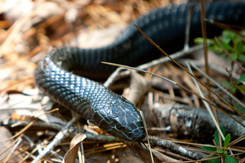 In 2005, the Alabama Division of Wildlife and Freshwater Fisheries staff began investigating of the status of the Eastern indigo snake in the state. Two years of intensive field investigation did not discover any of this federally-listed species, so the department, along with several partners, began to reintroduce them.
In 2005, the Alabama Division of Wildlife and Freshwater Fisheries staff began investigating of the status of the Eastern indigo snake in the state. Two years of intensive field investigation did not discover any of this federally-listed species, so the department, along with several partners, began to reintroduce them.
Since 2010, 78 wild indigo snakes into the Conecuh National Forest in Alabama. According to the USDA blog:
Some of the released snakes were bred in captivity from wild-caught snakes from Georgia through the cooperation of the Georgia Department of Natural Resources and Fort Stewart. The snakes were raised at Auburn University and the Atlanta Zoo. Each captive-raised snake with this project has been implanted with a passive integrated transponder tag for permanent identification as well as a radio transmitter to track and assess their survivorship. Auburn University will monitor the snakes movements and survival in the Conecuh National Forest.
In 2011, the US Forest Service recognized the Alabama Division of Wildlife and Freshwater Fisheries for their indigo snake restoration project. Other partners in the project include Conecuh National Forest, Auburn University, the Georgia Department of Natural Resources, The Orianne Society, the U.S. Fish and Wildlife Service, Zoo Atlanta, and the U.S. Department of Defense.
Oh, and the average indigo snake is about seven feet long, making it one of the largest snakes native to North America. It is not venomous.
You can read more about the project in a press release from the Alabama Department of Conservation and Natural Resources, here. (And no, I don’t feel the slightest bit sheepish about mentioning this release 20 days later. The “recent” award was given in 2011, after all.)
Here’s the press release from the time of the first snake release.
And here’s the USDA blog, with more information.
Photo: Indigo snake, courtesy of the Alabama Department of Conservation and Natural Resources.
